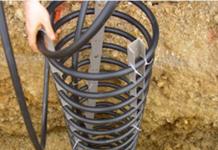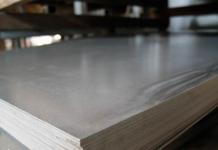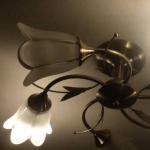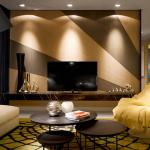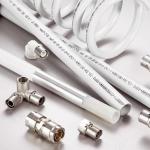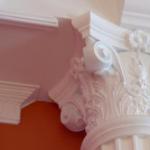An urgent problem when using LED lighting equipment as the main lighting is the periodic pulsation of the light flux. Why does the LED ceiling light blink when it is on? This is due to the characteristics of the LED matrix, which allows direct current to flow in only one direction, unlike incandescent filament lamps.
From an ordinary incandescent light bulb, the light also pulsates, but the electrons in this case can move in different directions, respectively, the flicker frequency is similar to the frequency of the mains alternating electric current (50 Hz). Therefore, the organs of vision do not feel such a flicker. The amplitude of the light pulsation is also minimal due to the incandescence of the spiral. The flow of light from such a light source has only one direction, respectively, due to the occurrence of changes in the mains voltage, the brightness of the lighting also changes.
In this article:
Types, causes of flickering of the LED element
Conventionally, two types of flickering of the LED source can be distinguished:
- up to 50 Hz - low-frequency;
- more than 50 Hz - high-frequency.
The causes of flickering can be conditionally divided into three categories:
- constant drop in mains voltage;
- low mains voltage, which does not allow the power supply circuit of the LED source to function fully;
- malfunction, design features of the power supply circuit of the LED source.
Low frequency flickering of the LED lamp
The amplitude of the alternating mains voltage changes with a frequency of 50 times / sec, has the form of a sinusoid. The glow of the matrix is provided exclusively by positive, negative half-waves passing through the LED. If an illuminator equipped with LEDs blinks, this may be the reason for significant savings on the power supply by the manufacturer.
In inexpensive models of such lighting equipment, a single-bridge rectifier is often used to reduce its cost, designed to convert AC voltage to DC. A certain number of oscillations are cut off after the diode bridge, and by adding a capacitor to the electrical circuit, the ripple is reduced. Such a scheme allows you to observe the pulsation of the light flux with a frequency of 25 times / sec.
Important! If the illuminator using LEDs continues to blink even after adding a normal bridge-rectifier to the circuit, then the problem is most likely in the capacitor.
The capacitor, as a rule, accumulates charge at the amplitude maximum and returns to the load at the minimum. At the output, the average voltage amplitude decreases, and the ripple becomes much less. With insufficient capacity of the resource, the capacitor is not enough to feed the LED elements, in which the brightness changes with each half-wave. The pulsation of the light flux according to sanitary standards should not be more than 10 percent of the nominal intensity.

How can the flickering of the LED light source be prevented in this situation?
You can prevent blinking of the LED lamp using a rectifier bridge for diodes, a high-capacity capacitor.

It is also worth knowing that even the highest quality lighting equipment using diodes will flicker at the time of mains voltage fluctuations. The effective voltage in the mains is 310 V (220 V - nominal). Quite often, especially in the evening, when the network is significantly overloaded with many household electrical appliances, a voltage drop of up to 180 V is possible. This, accordingly, entails the flickering of light sources.

Causes of branded lighting flickering
At low mains voltage, even if the light source is equipped with a capacitor of sufficient capacity, blinking is possible, since as a result of a decrease in amplitude, the capacitor will not have time to recharge. Such power surges occur periodically, but if they cause discomfort, you can additionally use a voltage stabilizer.
If the problems are completely fixed, but the LED elements continue to flicker when the lighting equipment is turned on, it is worth checking the quality of the contact connections on the switch, cartridge. Perhaps the contacts are oxidized.

Quite rarely, not the entire source blinks, but only a few LED elements. What is the reason for the individual LED of the LED ceiling lamp flickering when on, when the neighboring ones are working normally? This can happen if different types of crystals with a different power rating were used during the assembly of the matrix. Unfortunately, it is useless to deal with such a problem, and, most likely, some LED elements will fail very quickly.
It's important to understand! Blinking of lighting fixtures on LEDs with a low frequency, which can be determined visually, is detected instantly. It is enough to determine why this is happening.
Reasons for the flickering of the lighting device on the LEDs in the on state
The main reason why LED equipment can flicker is the poor quality of the LED matrix. The ripple of the output voltage, even in the power supply circuit of the classic version, is inevitable. For high-quality diodes, the saturation of the glow in the set voltage range is almost identical, due to which any ripple is prevented.
In the case of a low-quality matrix, even if the voltage drops by 0.5, the brightness of the light flux is already changing. In some cases, this situation can be corrected by installing a larger capacitor. But such a light source is not recommended for living rooms.
Recommendation! When detecting the blinking of a chandelier on LEDs, this phenomenon should not be ignored. This can lead to visual problems over time. You should definitely take the time to fix the problem, and if possible, return the low-quality light bulb to the seller.
Light-emitting diodes, or LED (Light Emitting Diodes), or rather their first samples, appeared in the middle of the last century, but wide interest in them from ordinary people appeared relatively recently. This is due to the fact that LEDs are gradually replacing the artificial light sources familiar to us (incandescent, halogen, fluorescent lamps, etc.). A few years ago, many could not imagine that LED technologies would become part of everyday life, and their scope would no longer be limited to indicators of electronic devices, information boards and toys.
The reason for the growing popularity is a number of advantages of LEDs over other light sources:
- The first and undoubted plus is the very long service life of the LEDs (approximately 50,000 hours).
- Low power consumption compared to other light sources.
- The economic benefit is the result of a combination of durability and energy savings.
- High light output. The LED converts almost all the energy received into light, unlike, for example, an incandescent lamp, which, with equal power, gives less light, and releases heat many times more.

Pendant lamp with LED matrix, XAL
- The ability to select the color temperature of the LED depending on the purpose of lighting: from the usual warm white light of an incandescent lamp (2700-3000K) to cool white or daylight (6500K). Here it is important to pay attention to such a parameter as binning - grouping by wavelength and color temperature of the LEDs. The fact is that unscrupulous manufacturers of cheap LED lamps or strips often do not ensure that all LEDs in the product have the same color bin. Therefore, it is very important when buying to check that the LEDs in the luminaire / strip / lamp do not differ in color or brightness.
- If the task is colored decorative lighting, then RGB LEDs are the best solution, since the number of colors and lighting scenes is limited in this case only by the designer's imagination. They make it possible to organize the illumination of any of the colors of the spectrum and change it using a special controller at your discretion.
- LED lamps can be dimmed (adjust the brightness of the light).
- The compactness, flexibility and variety of LED modules make it possible to implement many design lighting solutions in a wide variety of interiors.
- The LED does not heat up, as it operates at low voltage, which ensures a high degree of fire safety. Thanks to this property, LEDs are increasingly used in recessed luminaires, because the risk of getting burned by stepping on them with bare feet is reduced to zero.
- LEDs are resistant to mechanical damage due to the absence of fragile elements, such as a glass bulb or filament.
- The absence of phosphorus, mercury and other toxic elements allows us to talk about the environmental friendliness and safety of this light source.
And this is not a complete list of the benefits of LED lighting!
Disadvantages of LEDs
In connection with the above, a reasonable question arises about the cons and disadvantages of LED: are there any pitfalls? To this question, lighting specialists answer in chorus: “Price”.
Professional comment. Ekaterina Bukina, lighting designer: “The high cost is perhaps the only negative. LEDs are an almost perfect light source.”
Of course, the price factor is very important. On the other hand, the quick payback due to energy savings and the life of the LEDs makes this minus not so significant. Today, LED technology is advancing by leaps and bounds, competition among companies that produce LED products is increasing, all this, of course, leads to a gradual decrease in cost. It is likely that over time LEDs will become more affordable, although price reductions to the level of incandescent lamps are most likely out of the question.

With the help of LEDs, you can highlight the cornice of curtains, shelves or any other design.
In addition to the high price, there are a couple of drawbacks. First, the LED is demanding on the power supply. The need for an LED driver (power supply) not only increases the cost, but also raises the question of where to hide it, so that it is both invisible to the eye and accessible in case a replacement is required. Many lighting factories integrate power supplies into the luminaire housing, which greatly simplifies connection and installation.

Secondly, despite the long service life, the LED dims and loses brightness over time due to the degradation of the chemical and physical parameters of the light emitting crystal. The rate of degradation of the LED directly depends on the quality of the heat sink. Therefore, when buying LED products, you should pay attention not only to the price, but also to the manufacturer: it is better to choose a more expensive, but proven one in order to avoid unnecessary disappointments and additional costs. If we are talking about powerful LED strips, then you can take care of heat dissipation yourself, for example, by attaching the tape to an aluminum profile or strip. In other cases, everything depends on the design of the lamp and the integrity of the manufacturers.
Thirdly, if the LED in the matrix of the lamp or in the tape burns out for any reason, then it will be very problematic to replace it, and in most cases it is simply impossible. However, even today, some lighting factories are declaring that in the event of an LED failure, they have replacement elements.
http://www.ivetta.ua/
There is a myth that LED lighting is energy efficient, advanced and modern. In the media, LED lamps are often presented as a global trend of technical innovations, which is why many believe that LEDs consume a minimum of electricity, shine forever, their light is useful. But which of these is true? Almost nothing. LED technologies are effective only in a few narrow segments, where the miniature size and color saturation of color diodes are valuable. Before putting a diode light bulb at home, in an office, in a factory or a store, Vladimir Klichanovsky from Nova Light recommends understanding and learning some unpopular aspects of LED lighting
The super efficiency of LEDs is a myth. The amount of light emitted by a light bulb is measured in lumens, and the efficiency is measured in lumens per watt of energy expended. If you analyze this figure, and not just the power in watts, as most are used to, then this figure is not so impressive. On average, it is in the range of 70-80 lumens per watt for household bulbs and 90-95 for professional ones, while modern fluorescent bulbs operate at 100 lm / watt, and metal halide 120-135 lm / watt. Therefore, instead of replacing the light bulb with an LED one, it is sometimes easier to turn off half of the lamps, getting the same illumination and economical energy consumption.
The actual service life of LED lamps and fixtures is no longer than most modern lighting devices based on other technologies. An LED cannot work simply by plugging it into a power supply. It must be connected through an electrical converter (driver), which is subject to voltage drops, failures of individual components, overheating, etc. It is often impossible to replace it, so the entire lamp or light bulb needs to be replaced. In addition, the LED itself loses its lighting qualities, becomes cloudy, changes the light temperature towards a colder one. The actual useful life of an LED device is not able to exceed 20,000-25,000 hours, which is comparable to the life of modern fluorescent and metal halide lamps, which operate for 20,000-22,000 hours.
LEDs are not capable of transmitting colors and shades on a par with most other modern technologies.. White LEDs do not exist in nature. All white LEDs are made from blue ones by sputtering a phosphor (the composition is very similar to that used in the production of fluorescent lamps), which translates part of the blue emission spectrum into others. Therefore, LEDs betray blue shades well and very poorly - red, yellow and green. In general, LEDs are not even capable of transmitting even 80% of colors and shades, and manufacturers often manipulate the color rendering index, overestimating it, using outdated calculation methods. While the latest generations of fluorescent and especially metal halide lamps transmit up to 95-97% of colors and shades.
LEDs are harmful to human health. The predominant blue spectrum of LEDs prevents the human body from producing a hormone that is extremely important for health - melatonin, which is responsible for daily cycles. This leads to a number of negative consequences: from sleep and metabolic disorders to reduced immunity and susceptibility to cancer.
LEDs are the most intensely pulsing light sources. Almost all LEDs for their work require the conversion of the usual AC 110-220 Volts to DC, usually 12-36 Volts, which requires special converters. These features make it almost impossible to complete the task of eliminating or accelerating the pulsation to a comfortable level. So, modern fluorescent or metal halide lamps operate with a ripple of 38,000 hertz and a ripple coefficient of about 2.8%, while diodes in the predominant mass barely overcome 20%. In rare cases, this ratio is within 10%.
Pulsation leads to constant overstrain of the optic nerve and, as a result, constant fatigue and irritability.
LEDs have a negative impact on sales volumes. Trade volumes are directly related to the comfort of the buyer and the right hormonal background. Blocking the production of the hormone melatonin does not allow the human body to comfortably relax and form the necessary background for the production of other critical hormones, such as dopamine and oxytocin. High pulsation of light causes irritability and nervousness, and due to the low ability to convey warm red-saturated colors, the number of emotional reasons and incentives to make a purchase decreases. Due to these and many other factors, the time spent by the buyer in the store is reduced, which leads to a shortfall of up to 40% of potential sales.
LEDs spoil some food. The prevailing blue spectrum in LEDs destroys the structure of vitamin B 2 in milk after 4 hours, even if it is stored in opaque packages, so the taste of this product changes.
LEDs reduce labor efficiency in production and in the office. Due to the factors described, blocking the production of the hormone melatonin and intense pulsation for a long time inevitably lead to rapid fatigue, the impossibility of prolonged concentration, irritability, chronic fatigue syndrome, and contribute to the emotional burnout of employees. As a rule, this is accompanied by a decrease in labor productivity, an increase in excessive nervousness in the team, the appearance of intrigues, squabbles, etc.
LEDs are dangerous for children's eyes. The radiation area in the LED is extremely small and intense per unit area, therefore, in combination with intense blue spectrum radiation, it can lead to partial damage to areas of the retina in young children with direct exposure. The use of lamps (especially with an open LED) is extremely dangerous for children's eyes.
Street LED lighting leads to a decrease in the population of urban animals and birds. Excessive brightness of LEDs against the backdrop of pulsation and the prevailing blue spectrum in cities that have switched to LED lighting has led to a disruption in the daily cycle of many urban animals and birds, and they have left the cities. In some cases, population loss was up to 50%.
In some industries, the use of LEDs poses a direct threat to human life and health.. Excessive pulsation of LEDs can lead some people to a strobe effect, which is extremely dangerous in industries using moving mechanisms (knives, cutters, etc.). This effect leads to the impossibility of recognizing the movement and carries the risk of injury, and sometimes a threat to the life of workers.
sp-force-hide ( display: none;).sp-form ( display: block; background: #ffffff; padding: 15px; width: 410px; max-width: 100%; border-radius: 4px; -moz-border -radius: 4px; -webkit-border-radius: 4px; border-color: #dddddd; border-style: solid; border-width: 1px; font-family: Arial, "Helvetica Neue", sans-serif; background- repeat: no-repeat; background-position: center; background-size: auto;).sp-form .sp-form-fields-wrapper ( margin: 0 auto; width: 380px;).sp-form .sp-form -control ( background: #ffffff; border-color: #cccccc; border-style: solid; border-width: 2px; font-size: 15px; padding-left: 8.75px; padding-right: 8.75px; border-radius : 4px; -moz-border-radius: 4px; -webkit-border-radius: 4px; height: 35px; width: 100%;).sp-form .sp-field label ( color: #444444; font-size: 13px; font-style: normal; font-weight: bold;).sp-form .sp-button ( border-radius: 4px; -moz-border-radius: 4px; -webkit-border-radius: 4px; background- color: #c34511;color: #ffffff;width: auto;font-weight: bold;).sp-form .sp-button-container ( text-align: right;)
LED lamps are a relatively new phenomenon in the Russian lighting market. The appearance of this innovative product causes heated debate among specialists and gives rise to polar opinions among consumers. So what is LED lighting and what are its main advantages and disadvantages?
Scope of led-lamps
The abbreviation LED stands for Light Emitting Diode and literally translates as "diode that emits light." Indeed, an LED is a semiconductor device, passing through which an electric current is converted into light. The first LED lamps appeared about ten years ago, but they were of little use as the main light sources, since the luminous flux emitted by them was rather dim. Such products were suitable only for the role of a night light. Today, the situation has changed dramatically, and thanks to the improvement of technical characteristics, LED lamps are able to illuminate vast areas, imitating daylight and providing excellent visibility at night.
 The scope of led-lamps is incredibly wide. They are used to illuminate city streets - highways, parks, courtyards, surrounding areas; industrial and production facilities, warehouses, parking lots, gas stations, airports and sports facilities; housing and communal services - to illuminate areas in front of entrances, landings, basements and elevators; for indoor lighting of premises - offices, educational and medical centers. LED lamps are also used to create a decorative effect, namely to illuminate buildings, fountains, flower beds, advertising signs. Recently, even household LED lamps for home use have become popular. Literally wherever light is needed, these lamps can be used. And they have received such wide distribution, obviously, not in vain.
The scope of led-lamps is incredibly wide. They are used to illuminate city streets - highways, parks, courtyards, surrounding areas; industrial and production facilities, warehouses, parking lots, gas stations, airports and sports facilities; housing and communal services - to illuminate areas in front of entrances, landings, basements and elevators; for indoor lighting of premises - offices, educational and medical centers. LED lamps are also used to create a decorative effect, namely to illuminate buildings, fountains, flower beds, advertising signs. Recently, even household LED lamps for home use have become popular. Literally wherever light is needed, these lamps can be used. And they have received such wide distribution, obviously, not in vain.
Benefits of using LED lights
Let's start assessing the quality of the products under discussion, perhaps, with a review of the advantages that LED lamps really have a lot of.
- First of all, LED lamps are environmentally friendly. Unlike halogen and fluorescent lamps, they do not emit carbon dioxide and do not contain mercury or other toxic substances. The use of LED lamps is absolutely safe for the environment and human health.
- The use of LED lamps allows you to save up to 70% on energy consumption compared to conventional gas-discharge and mercury lamps. The benefit from their use is also increased due to the absence of the need for regular maintenance and replacement of light bulbs. LED lamps can last up to 100 thousand hours with daily continuous operation in any climatic conditions and with power surges.
- The peculiarity of the optical system of led-lamps provides uniform illumination of the space, without the effects of color spots, stripes, pulsations. The choice of models is so wide that among them you can easily find devices for any purpose. Consider, for example, street lighting. Models for lighting inside yard areas provide excellent visibility to pedestrians, but at the same time they do not blind drivers and do not interfere with residents of the house. And console models have the power to evenly illuminate even large tracks. Here you can get acquainted with the variety of models of LED lamps for street lighting and see for yourself that whatever your task is, it can be solved with the help of LED devices.
- LED lamps have a solid construction. The internal microelements of the device are protected by a reliable case made of metal and polycarbonate shockproof glass. Luminaires withstand temperature fluctuations over a wide range, are resistant to vibrations and mechanical stress and are not afraid of moisture and dust.
The disadvantages of such lighting
 Well, now about the cons. In fact, the disadvantage of LED lamps is only one - their price. LED lamps are really expensive and if you replace an outdated lighting system with a modern one using LEDs, you will have to spend a significant amount. However, is the high cost really a disadvantage when you are making such a long-term investment in devices with many benefits?
Well, now about the cons. In fact, the disadvantage of LED lamps is only one - their price. LED lamps are really expensive and if you replace an outdated lighting system with a modern one using LEDs, you will have to spend a significant amount. However, is the high cost really a disadvantage when you are making such a long-term investment in devices with many benefits?
The implementation of a lighting project using such lamps will pay off already during the first years of operation and even before the end of the warranty period of the devices. In the future, the annual savings from the use of, for example, street led lamps (based on the replacement of 250 conventional light sources) will amount to 1.26 million rubles. in comparison with traditional ZhKU 16–250 devices. Savings over 5 years will amount to 6.31 million rubles, over 10 years - 12.6 million rubles.
To make your lighting investment worthwhile, it is important to choose a reliable LED supplier. By starting cooperation with TechInvest, you can be sure of the highest quality of the goods offered. TechInvest sells wholesale LED lamps for various purposes only from Russian manufacturers, which will allow you to purchase high-quality lighting equipment at affordable prices. The company's specialists will assist in choosing the right devices for you, as well as prepare a feasibility study (feasibility study) to calculate the payback period for led-lamps.
So, as you can see, the popularity of innovative lighting fixtures is deservedly deserved. Our analysis of LED products has shown that with a rational approach to the cost of installing LED-lights, the only inherent disadvantage is insignificant in comparison with the benefits that you gain. And if you've been looking for efficient, low-energy lighting, then LED luminaires certainly fit the bill.
LED lamps are modern equipment that has appeared on the domestic market relatively recently. LED lights are quite expensive. But at the same time, they usually serve much longer than simple incandescent lamps. LED equipment is actually quite reliable. But unfortunately, sometimes it still happens that the LED device starts blinking or even fails altogether. Why LED lamps burn out - we will deal with this later in the article.
Main reasons for failure
The LED lamp may burn out due to:
faulty electrical wiring in the house;
lamp or chandelier malfunctions;
poor build quality.
Wiring Condition
Very often, the owners of houses and apartments are interested in why LED lamps burn out constantly. The reason in this case, most likely, lies in the faulty wiring. In order to fix this problem, you should call the building management and call electricians. Experts will check the network and fix any problems.
Of course, you can inspect the wiring in the house yourself. But this should only be done if you have some experience with networks. First of all, it is worth checking all the junction boxes in the apartment. The twists present in them (and even more so copper and aluminum wires) should be eliminated. To connect the wires, you need to use special sleeves, pads or adapters.
It is also worth checking the condition of the wiring directly at the point where the chandelier or lamp is connected to the general house network. Poor contact here is also often the answer to the question of why the LED lamps in the apartment burn out.

Such equipment can also fail due to power surges in the network. It is for this reason that LED-devices sometimes have to be changed in summer cottages. After all, outside the city in Russia, the tension is rarely stable. In this case, nothing can be fixed, most likely. Instead of LED, home owners will have to use conventional incandescent lamps. You can also buy some powerful stabilizer. For example, Resant devices are often installed in dachas. With such equipment, it will most likely be possible to use LED lamps in the house. However, "Resanta", unfortunately, when switching can also give strong power surges.
Why LED lamps burn out: the state of the chandelier
Sometimes such problems with LED-devices arise due to a malfunction of the lamp itself. Therefore, such equipment should also be carefully inspected. In doing so, you need:
Inspect all contacts in the cartridge. If necessary, they should be cleaned. In particular, this applies to the "tongues", which it is also desirable to bend up. All these actions in the future will ensure reliable contact between the lamp and the cartridge.
Check all fasteners. It often happens, for example, that the screw is loosely tightened on the cartridge. And this, in turn, usually leads to sparks and burning. The voltage in the lamp due to weak contacts is unstable. This is the reason why LED lamps burn out quickly.

Poor quality of the equipment itself
On sale today there are LED devices from both eminent European manufacturers, as well as Chinese or domestic ones. The first ones are quite expensive, but at the same time they are reliable. Mostly Chinese lamps burn out quickly. This is explained primarily by the low quality of their assembly. Domestic equipment of this type is considered relatively reliable.
Voltage drops LED-devices, as already mentioned, do not tolerate. Therefore, their design includes a special mini-stabilizer - the “driver”. In particular, increased voltage has a bad effect on the durability of the LED lamp. The Chinese, when assembling, try to make the ice bulb look “beautiful”, first of all, in the store. Stands in the lighting engineering shopping center usually do not charge for a long time. And to make the light bulb look “worthy”, the Chinese put a weak current limiter on it. Therefore, when turned on at the stand, it lights up with a bright light. And therefore, it looks good in the store. When connected to a household network, such a device will experience severe overloads and eventually burn out.
Of course, not all Chinese manufacturers supply such low-quality goods to the market. However, the risk of "running into" a potentially short-lived LED device made in China is quite high.

Why is it on
However, such devices rarely burn out. More often than not, the malfunction of LED lamps is manifested in the fact that they begin to blink. This can happen both when the device is turned on and when it is turned off. In the first case, the cause of blinking can be:
poor-quality installation of the device;
old wiring in the house;
the switch is not in phase, but at "zero";
poor-quality driver in the lamp itself;
phase shift.
Sometimes it also happens that the light goes out after turning on, and then lights up. This indicates primarily a malfunction of the starter.
What to do when the device flashes when it is on
The first step to fix this problem is to check all the contacts on the network. If this does not help, you may have to think about replacing the wiring in the apartment. In old high-rise buildings, aluminum wires are usually stretched. There are many powerful devices in apartments today. Therefore, it may simply not cope with the load. If the flashing occurs for this reason, the wires must be replaced with copper ones.
If the light blinks simply due to a malfunction, you can try the following:
get the filling of the device and insert the driver there;
to stabilize the lamp, solder another capacitor into it;
use one driver for all light bulbs in the device.

Blinking when off
This error may be due to:
The presence of LED lighting in the switch. The current flowing through it, over time, can recharge the lamp capacitor. As a result, a weak glow occurs. To prevent this from happening, you can try replacing one of the LED devices with a conventional incandescent lamp. This device will simply "take" the excess voltage onto itself. His strength to light an incandescent lamp is simply not enough.
Non-compliance of the lamp itself with quality standards.
In the off state, often due to a malfunction in the wiring of a house or apartment. Also, in some cases, a similar phenomenon occurs due to the operation of a large number of sources of high-frequency interference (microwave ovens, electric stoves, washing machines, etc.). In this case, you can fix the problem by including a stabilizer with a filter in the network circuit.
Lamp selection. Which one is better to buy?
The answer to the question of which LED lamps are better depends primarily on the design features of the device and its technical characteristics. When buying LED, you should pay attention primarily to the following factors:
Flask type. Most often, owners of apartments and houses purchase (for chandeliers) and E14 (for small lamps). Such LED-devices can be produced in the form of a bulb or "corn". In the latest version of the lamps, the contacts of the LEDs are energized on the outside. Therefore, they are considered non-flammable. For a house or apartment, it is better to purchase all the same lamp bulbs. A very good choice would be, for example, an E27 LED ball lamp. Such devices in terms of safety and reliability of the design are considered to be of sufficient quality.
Light flow. For devices from good manufacturers, this figure can range from 900-1000 lumens per watt of power. For example, 10W can have a luminous flux of 700-900 lumens. If the seller assures the buyer in the store of other, better, characteristics of the device, he should not be trusted. LED lamps with an efficiency of 1300 lumens are too expensive. And therefore, it is simply impractical to produce them for apartments.
The light temperature of the lamp. Of course, for an apartment, you should choose a “warm white” LED device.

Is it worth it to buy on Aliexpress
It is, of course, necessary to pay attention to the characteristics of the lamp when buying it. But it is equally important to look at the brand of the manufacturer. In particular, this applies to those cases when the owners of the apartment decided to save money and purchase a Chinese LED device. After all, the answer to the question of why LED lamps burn out often lies precisely in the poor quality of their assembly.
The best manufacturing companies
If we continue to talk about the Celestial Empire, then the answer to the question of which LED lamps are better is the products of the following companies:
Camilion. The lamps of this manufacturer belong to the budget category and are sold not only in Russia, but also in Europe. Most consumers believe that their quality is relatively good.
Maxus. In terms of quality, "Camilion" lamps from this manufacturer are inferior. But still they are considered quite reliable. Most consumers advise purchasing them, for example, for a summer residence or a garage.
It is better not to purchase lamps from unknown Chinese manufacturers at all. Such an LED bulb will most likely not last too long.

Of the Russian manufacturers of LED lamps, the most popular are:
"Optogan";
"Svetlana-Optoelectronics".
There are, of course, good, relatively inexpensive lamps from European companies on the domestic market. The best such manufacturers are Gauss, Osram and Philips.

